The Van Rysel D900 is Decathlon’s new high-end direct-drive smart trainer.
Sitting at the top of Van Rysel’s new range of smart trainers, the D900 has some specifications that compete with many of the best smart trainers.
Despite this, though, the Van Rysel D900 is aggressively priced at just £549.99 / €600.
In use, it largely delivers, offering good ride feel and ERG mode performance, easy setup and quiet operation.
However, a few details, such as data imperfections and a lack of some quality-of-life features, hold it back from a higher score at this increasingly competitive price point.
Van Rysel D900 specification
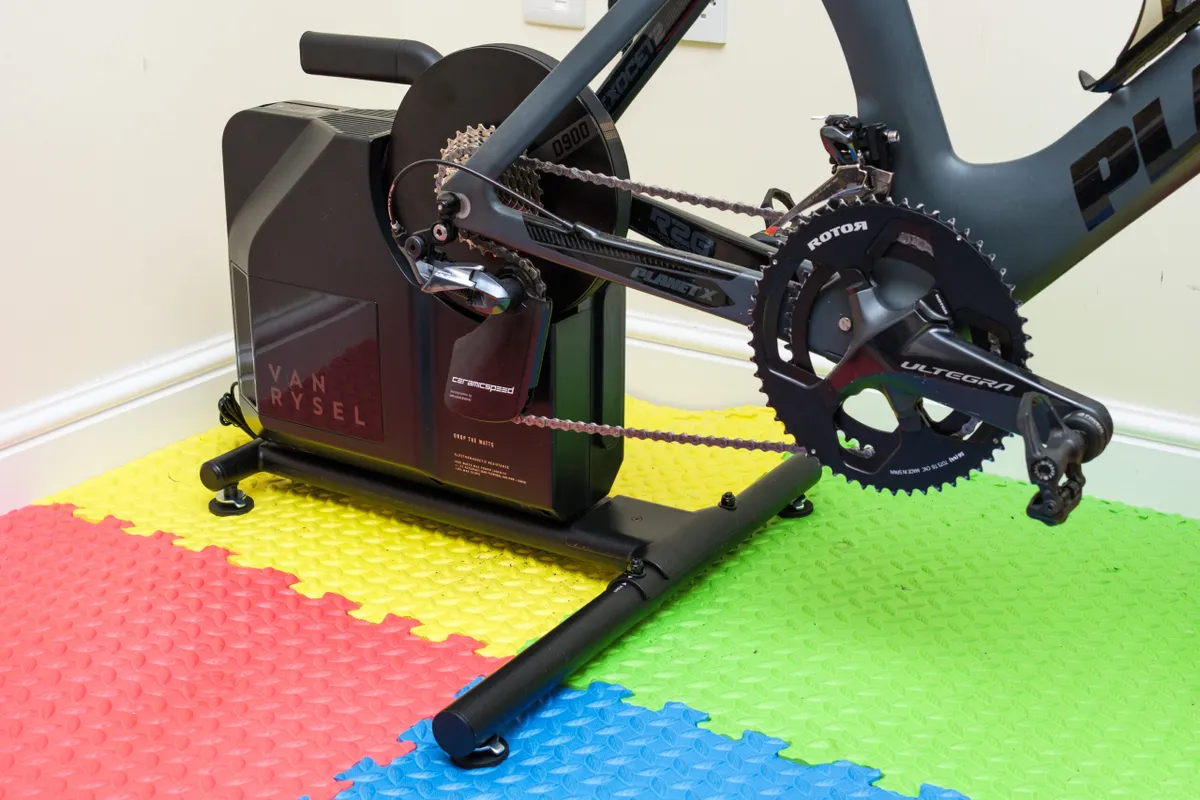
The Van Rysel D900 is a direct-drive smart trainer, meaning you remove the rear wheel from your bike and mount it directly to a hub and cassette on the trainer.
As noted, the D900 sits at the top of Van Rysel’s smart trainer range. Accordingly, it gets the highest spec on offer.
It has a claimed maximum power output of 2,000 watts, for example, and can simulate gradients up to 20 per cent.
On paper, these specs are competitive with some smart trainers costing much more, such as the Wahoo Kickr V6 (£1,099 / $1,299 / €1,299.99) and the Elite Justo (£999.99 / $1,199.99 / €949.99).
Beyond that, the D900 is claimed to be able to measure power to an accuracy of +/- 2 per cent.
This range isn’t as tight as on the Wahoo Kickr V6 or Elite Justo, both of which are claimed to be accurate to +/- 1 per cent (and impressed in this area during testing), but it is competitive for its price point.
The Wahoo Kickr Core (£549.99 / $599.99 / €549.99) and recently discontinued Zwift Hub (£549 / $599 / €599), for example, offer accuracy ranges of +/- 2 per cent and +/- 2.5 per cent, respectively.
Elite’s Suito (which recently saw its price drop to £499 / $599 / €549), meanwhile, offers a claimed accuracy of +/- 2.5 per cent, while the Direto XR (now £599 / $699 / €699) sits at +/- 1.5 per cent.
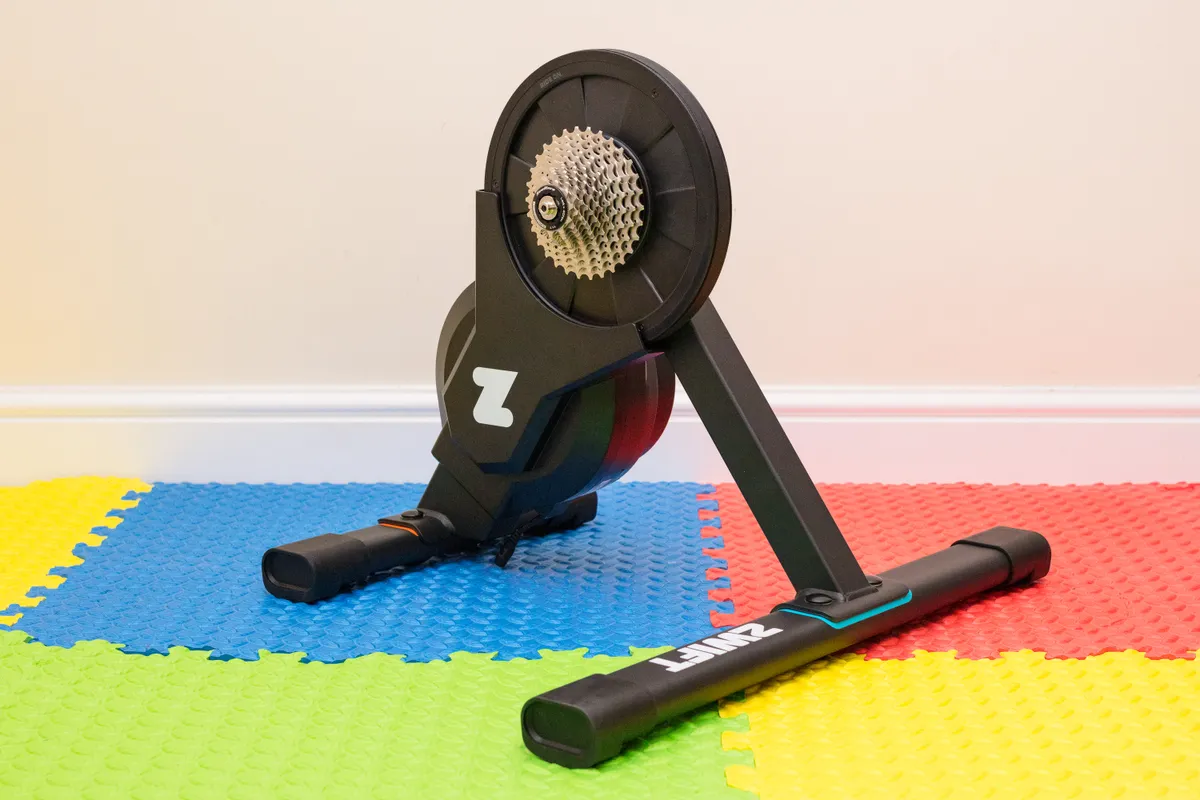
It’s worth noting the Wahoo Kickr Core (and recently announced Kickr Core Zwift One) includes a choice of cassette and a year’s subscription to Zwift (worth £129.99 / $149.99 / €149.99), the popular virtual indoor cycling app, though. The Van Rysel D900 does not.
That said, Van Rysel includes a one-month trial of the Onelap virtual indoor cycling app. This is said to offer a gamified experience in a 3D virtual world, alongside structured workouts.
I suspect most riders will – like me – look to pair the D900 with their favourite indoor cycling app, however, whether it’s Zwift, Wahoo SYSTM, Rouvy or (for those who prefer their indoor training to be boring) TrainerRoad.
Given this, you’ll likely need to factor in extra cash for both of these things, or check out one of the best free indoor cycling apps.
Van Rysel D900 setup
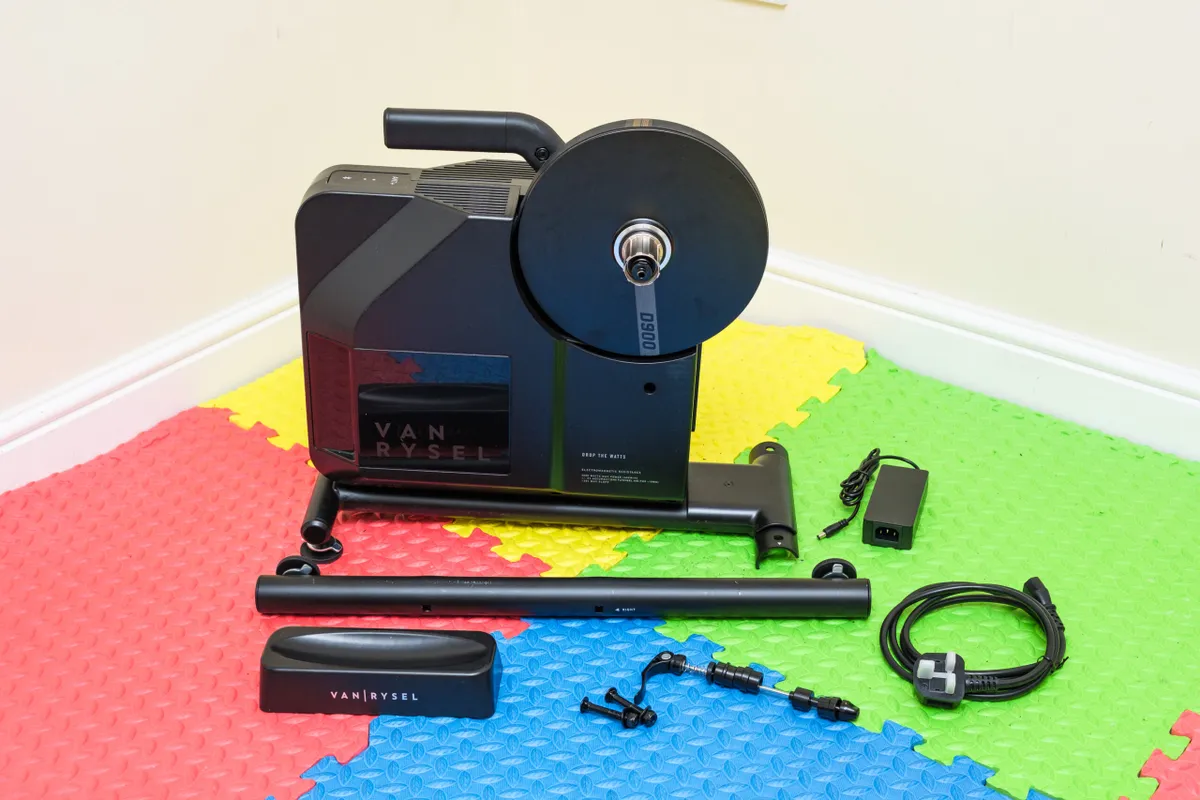
The Van Rysel D900 comes almost fully assembled. Setting it up only requires bolting on the front leg, adding a cassette and the right axle adaptors, and plugging it in.
The D900 doesn’t include a cassette, so you’ll need to supply your own, plus the tools to install it.
If you’re unfamiliar with the tools and techniques required for this job, check out our in-depth guide to replacing a cassette.
The Van Rysel D900 ships with a Shimano Hyperglide (HG) freehub, which is compatible with 8- to 12-speed Shimano cassettes.
If your bike has a SRAM AXS drivetrain, Decathlon also sells a SRAM XDR freehub, which can be purchased separately for £24.99.
There are no freehub options for riders with Campagnolo drivetrains, however. Riders with Campagnolo-equipped bikes may be able to make do with an equivalent-speed Shimano cassette on the stock freehub, but it’s unlikely to offer optimal shifting performance.
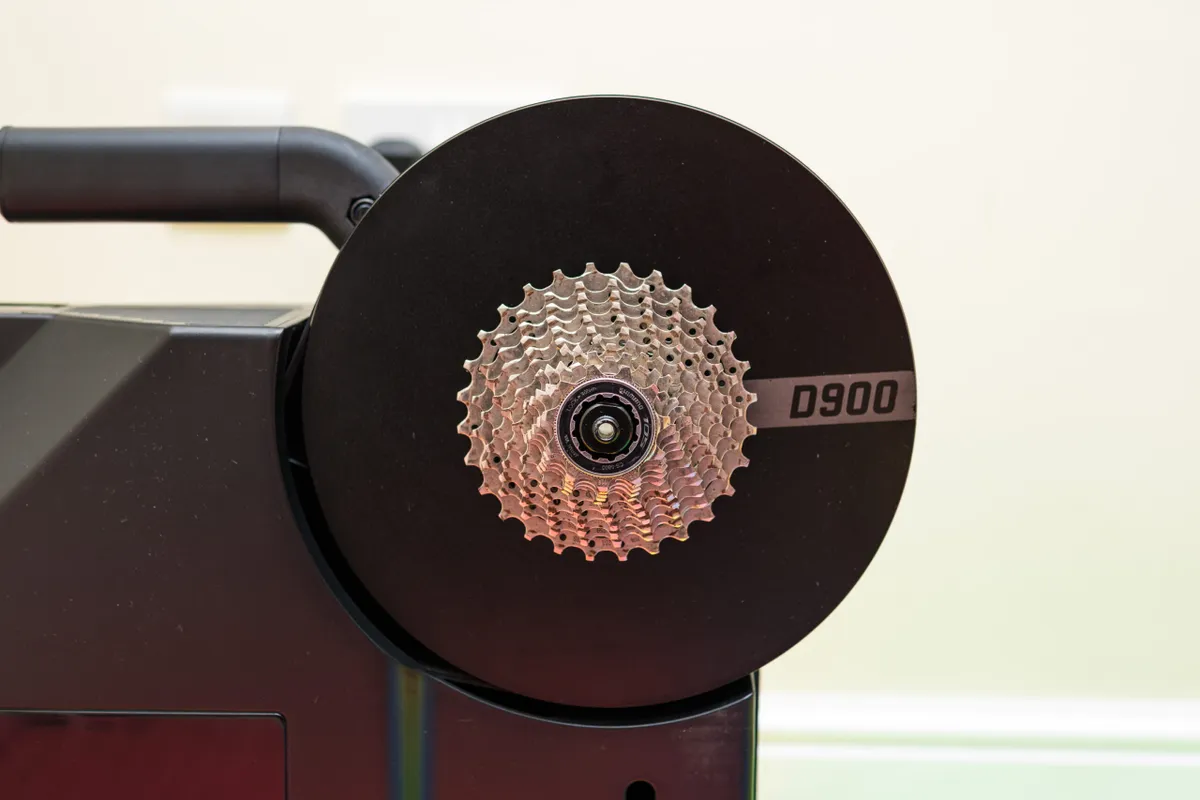
It’s also worth noting the Van Rysel D900 doesn’t ship with the spanner required to bolt on the front leg.
I have a basic tool kit for maintaining bikes, which includes a couple of adjustable spanners, so this wasn’t an issue for me.
Given the cheap tools typically included with devices such as smart trainers are generally low quality (because they are, in fairness, designed to be used sparingly), missing out on one didn’t feel like a loss.
Of course, those who need to buy a spanner to assemble the D900 might feel differently.
In any case, once the front leg is bolted on and a cassette is installed, you’ll need to select the right axle adaptors for your bike.
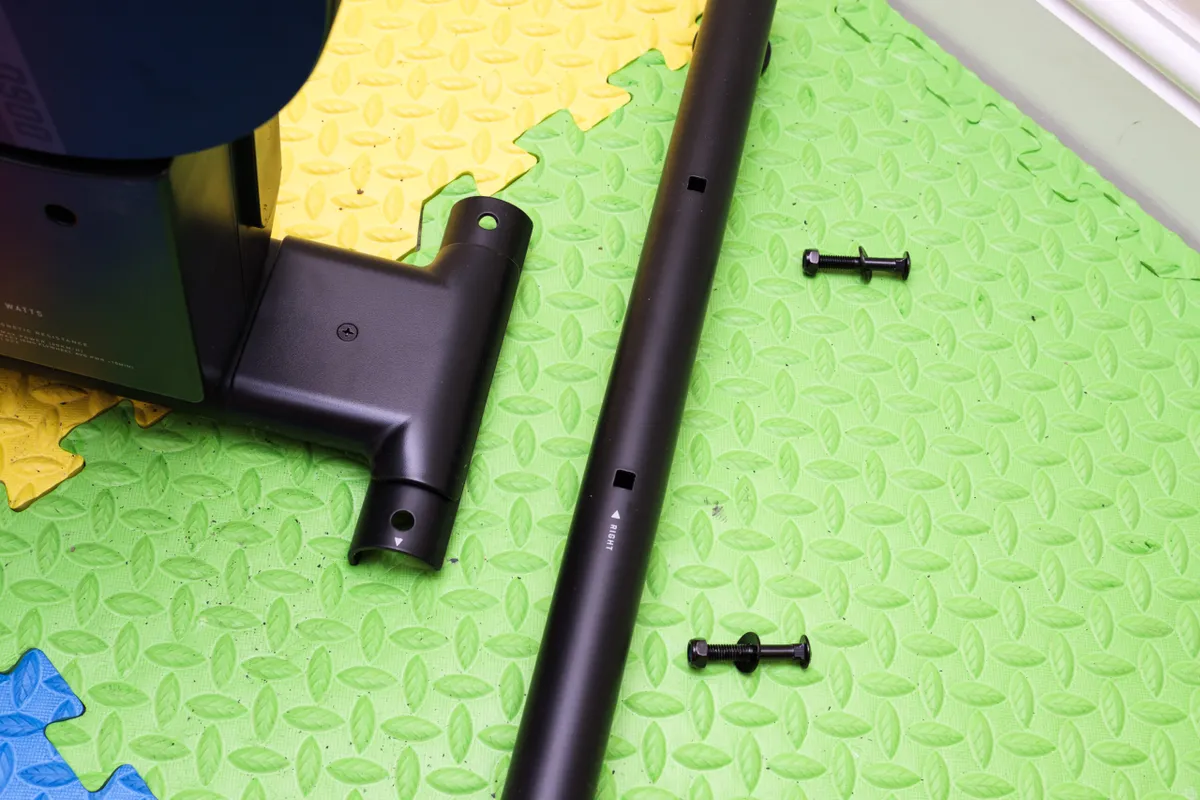
The Van Rysel D900 doesn’t include colour-coded adaptors, instructions and measurement tools like the Zwift Hub. Nor are the adaptors labelled, as they are with the Wahoo Kickr V6 or Kickr Move.
The instructions included with the D900 include useful diagrams, and if you know what the rear axle spacing of your bike is, this is a simple task. It might take a bit of trial and error to find the right set for your bike if you’re unsure, however.
A usefully sized handle is included for moving it around and, at 19kg, the Van Rysel D900 isn’t overly difficult to manoeuvre into place.
It also has a slim overall profile, but – as is fairly typical for smart trainers at this price – the support legs don’t fold away. You’ll need to remove the front support leg to make it as compact as possible for storage, then.
A front-wheel riser block is included to level out your bike, though its slim form factor means it doesn’t offer a great deal of front-end stability. After one ride, I swapped in a wider one made by Elite.
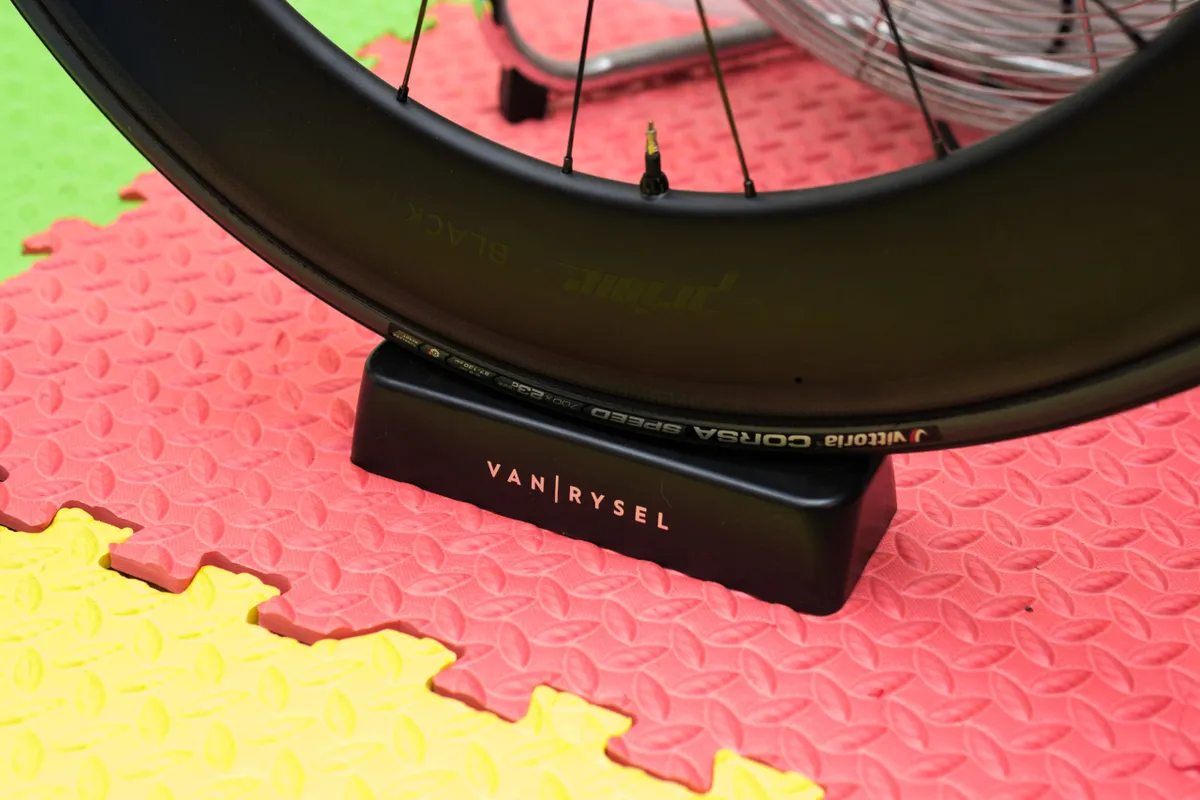
Van Rysel D900 performance
Van Rysel D900 connectivity
Like most smart trainers at this price, the Van Rysel D900 can connect to smart devices and bike computers via Bluetooth or ANT+.
Unlike some higher-end smart trainers, there’s no option to connect to a local internet network, either via Wi-Fi or an ethernet adaptor.
For most riders – myself included – Bluetooth is perfectly sufficient, though.
I didn’t have any difficulties connecting the Van Rysel D900 to Zwift on a MacBook Pro or an Apple TV, nor did I experience any data dropouts during use.
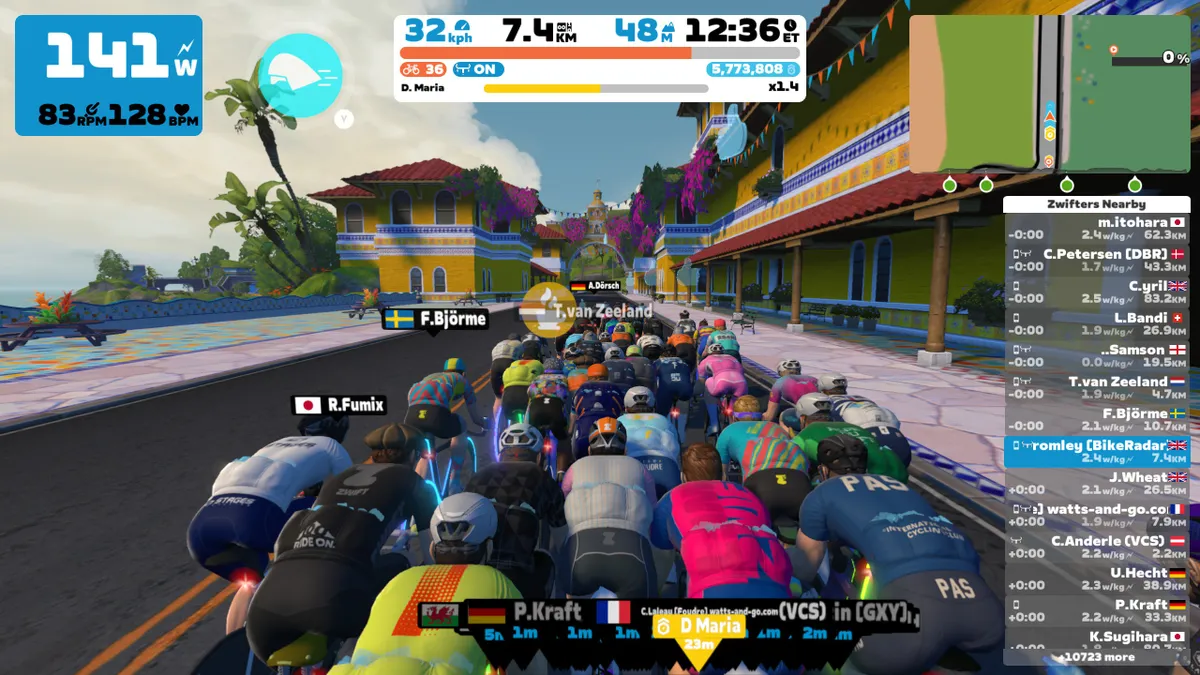
Unlike the Elite Justo and Wahoo’s Kickr V6 and Kickr Move, the Van Rysel D900 doesn’t offer a ‘Race Mode’ with increased data transfer speeds. This typically sees data transmitted at 10Hz rather than the standard 1Hz and is a marginal gain feature for virtual racing (effectively, it enables quicker reactions to other riders' attacks).
With the Zwift Hub now out of the picture, though, there are few trainers at this price that offer this feature.
A more ubiquitous feature the Van Rysel D900 lacks is the ability for the trainer to act as a connectivity bridge for an ANT+ heart rate monitor or other sensors.
This can also be useful when using an app on a device with limited Bluetooth connection slots (such as Apple TV), freeing up a channel for accessories such as Zwift’s Play controllers or a cadence sensor.
On Zwift, you can use a smartphone and the Zwift Companion app to act as a bridge instead (provided you have a good Wi-Fi connection), but not all apps offer this functionality.
OneLapFit app

Firmware updates, settings customisation and spin-down calibrations are handled by the OnelapFit app, which is available for iOS and Android devices.
Developed by Magene (a Chinese manufacturer of smart trainers, bike computers, power meters, heart rate monitors and more), the app itself is designed to work with a number of different Magene devices, not only Van Rysel smart trainers.
I was able to check the firmware was up to date and perform a spin-down calibration without issue.
Later, though, when coming back to double check some settings, it surfaced an intrusive, AliExpress-style ‘lucky prize wheel’ pop-up when I opened it.
Of course, adverts within brand apps are nothing new – Wahoo’s app contains plenty of information about its latest promotions, products and events, for example.

The difference here is in the manner this is presented, though. For me, a pop-up that blocked out the screen and forced me to engage feels a step too far.
Fortunately, this doesn’t happen every time you open the app (and, in fact, it hasn’t happened again since), but it was annoying nonetheless.
Van Rysel D900 ride feel
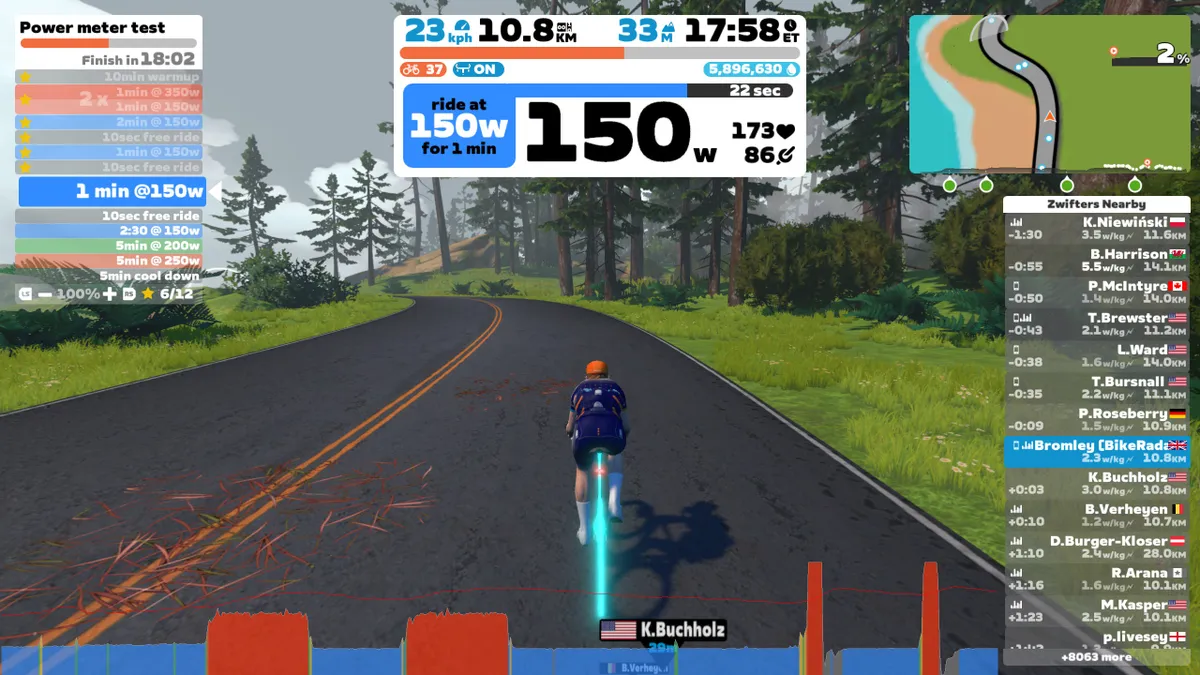
On paper, the Van Rysel D900’s 5.2kg flywheel outclasses the Zwift Hub’s 4.7kg version, slotting in just behind the Wahoo Kickr Core’s 5.4kg.
On paper, bigger numbers are better here because a heavier flywheel can store more energy. This can then enable a trainer to generate more inertia and the feeling of momentum you get when riding out in the real world.
In reality, though, all three trainers feel comparable – in a good way – in terms of feel through the pedals and how smoothly they handle the transitions through gradients.
I was also impressed by how the Van Rysel D900 handled ERG mode workouts. Ramp-ups in power were smooth, taking four to five seconds to go from 175 to 350 watts, for example. It also held a consistent power level well.
Van Rysel D900 noise
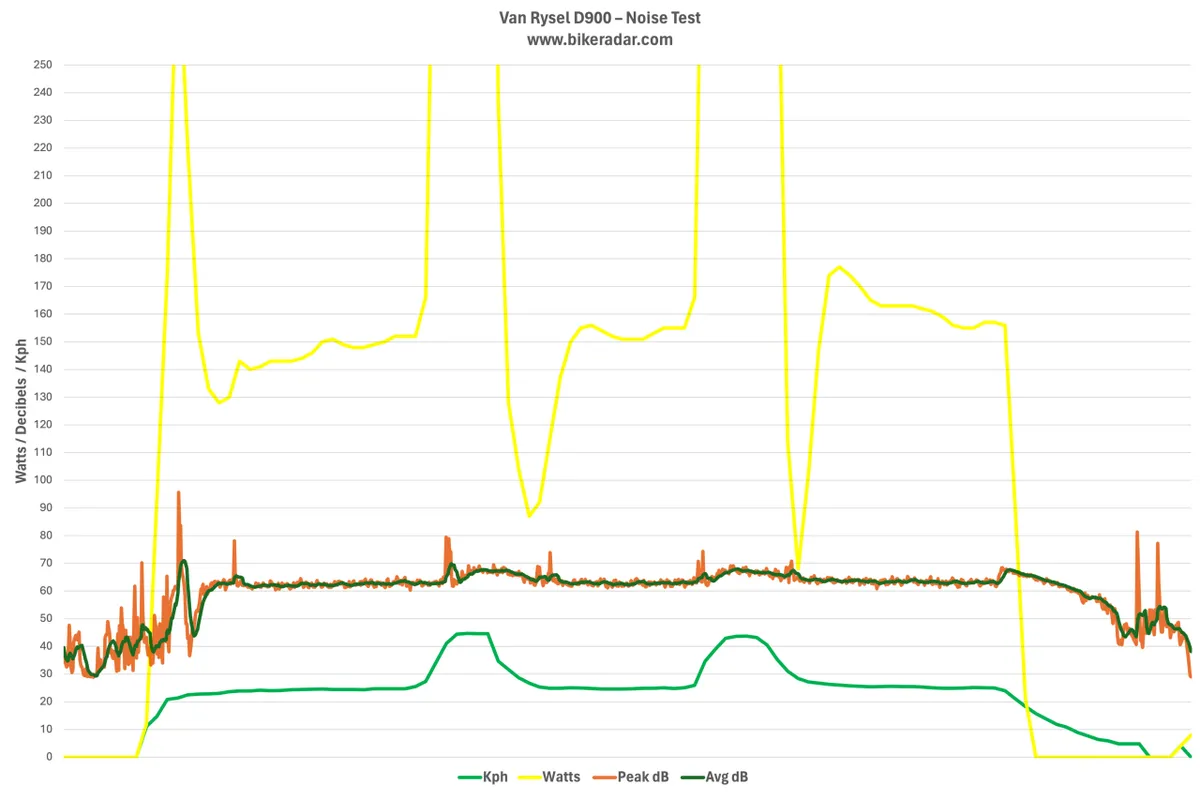
Decathlon claims the Van Rysel D900 is “really silent”, and while this isn’t true, in practice it is a decently quiet smart trainer.
Putting it through my standard trainer noise test, the Van Rysel D900 averaged around 63 decibels at 150 watts / 25kph, rising to around 68 decibels at 45kph during sprints.
This test involves recording decibel data from a ride on an iPhone placed one metre away from the trainer, parallel to the drivetrain side of my bike.
On paper, this is slightly louder than the quietest smart trainers available, but it’s likely still ‘quiet enough’ for most people. My cat – who has a bed near my trainer setup at home – didn’t feel perturbed enough to leave the room while I was doing a Zwift race, for example.
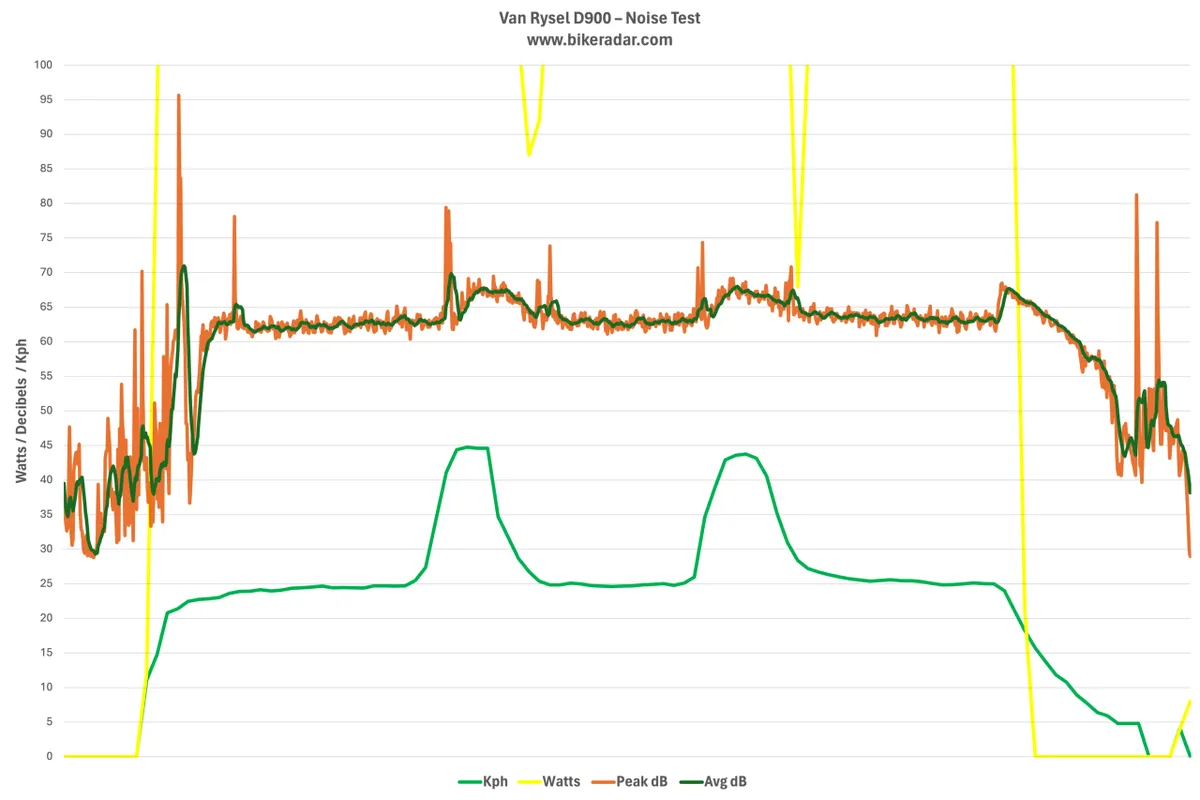
As always, your mileage may vary compared to my measured figures, depending on what drivetrain and chain lube you’re using.
In this instance, I was using a waxed chain on Rotor chainrings, with a Shimano 105 R7100 cassette. Stock Shimano chainrings, higher-end cassettes and oil-based chain lubes are all typically a little quieter, for example.
Van Rysel D900 power accuracy
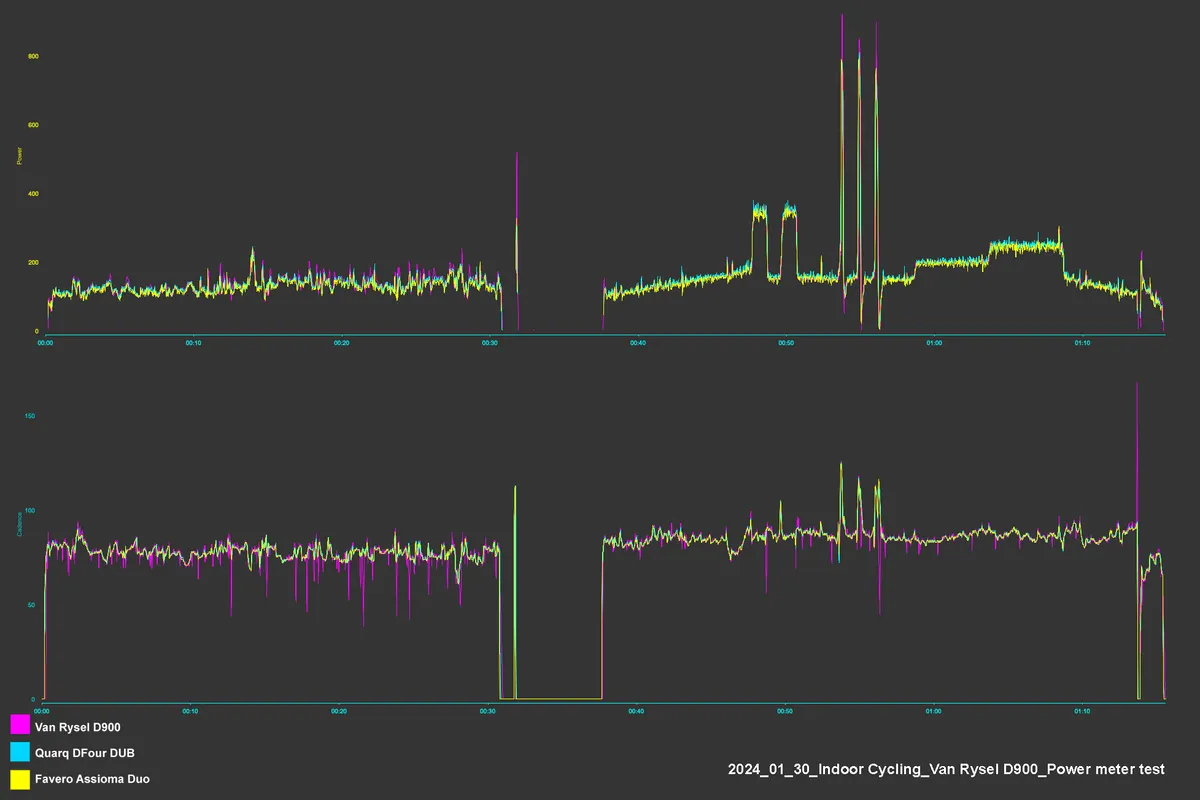
Power data accuracy was something of a mixed bag for the Van Rysel D900.
On average, the power numbers were generally within spec compared to benchmark on-bike power meters, such as Quarq’s DFour Dub spider or Favero’s Assioma Duo and Garmin’s Vector 3 power meter pedals.
Unfortunately, my sample consistently and significantly over-reported sprint power.
The magnitude of the error compared to my on-bike power meters was inconsistent, but it ranged from as little as 6 per cent up to nearly 17 per cent at its worst.
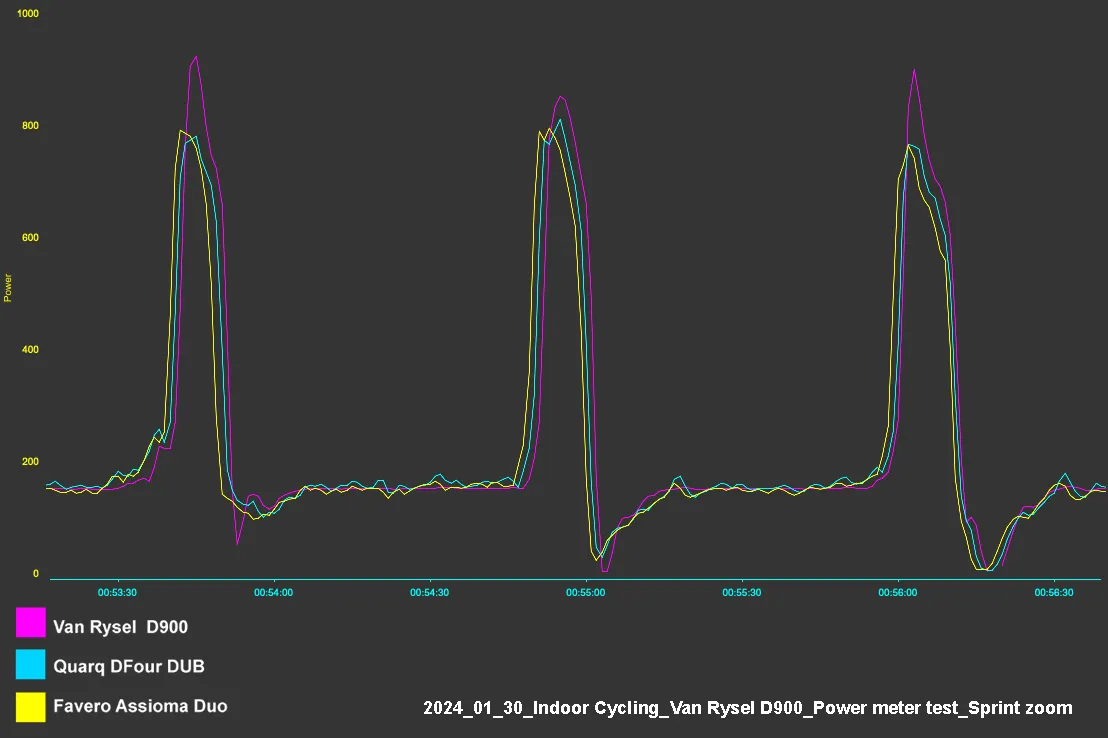
It also tended to over-report power at high flywheel speeds – such as when doing fast virtual descents or group rides.
Whenever I mentioned this trainer over-reports sprints to colleagues enquiring about its performance, I was unfailingly met with the response “Well, that’ll be great for Zwift racing, then!” (cyclists are such an honest bunch).
Of course, cheating in any kind of race, virtual or otherwise, feels quite sad.
But even setting that aside, these inaccuracies and inconsistencies would also affect the quality of your training, if your plan includes any sprint work and high-tempo virtual rides outside of ERG mode.
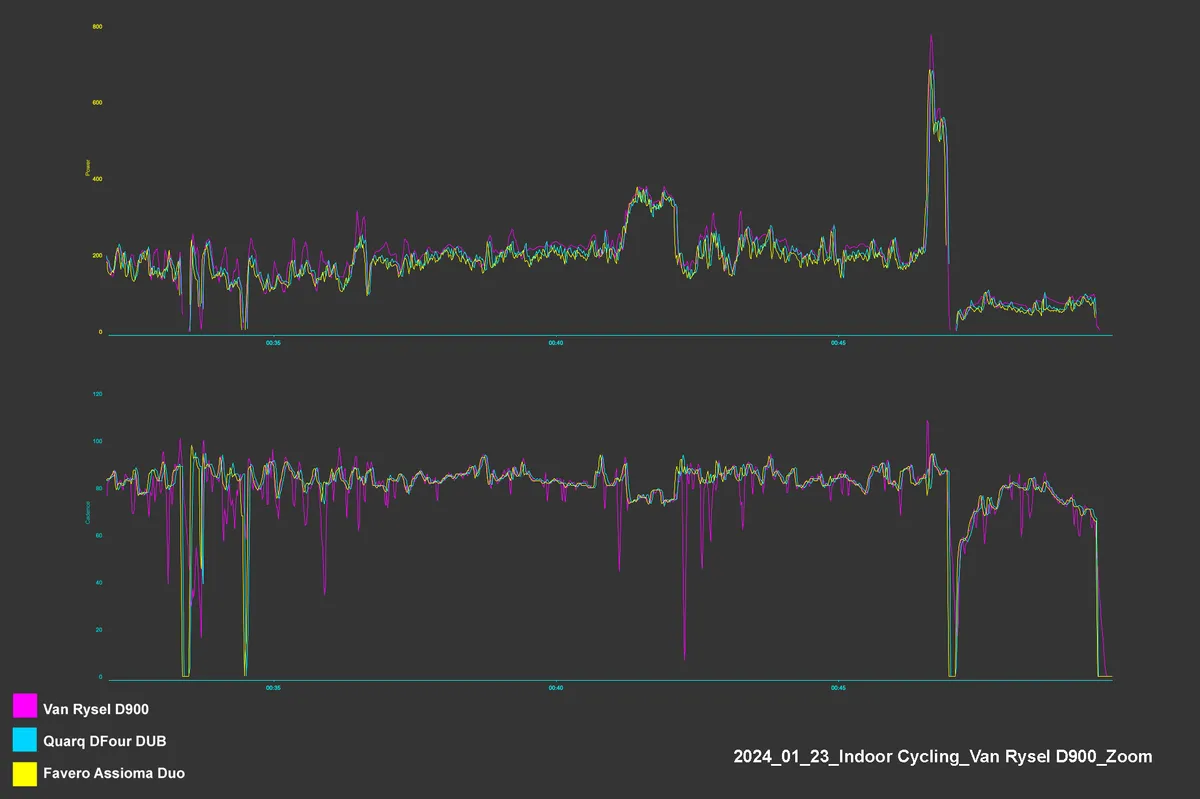
If your bike has a good power meter on it, you could instead connect this to your indoor cycling app of choice for better data quality (while keeping the smart resistance features connected).
This won’t be an option for everyone, however, and it’s fair to say this isn’t something you should have to do with a smart trainer at this price.
In terms of cadence, measurement accuracy was as good as expected for the price, but not perfect. As with the power accuracy, it tended to be better at lower flywheel speeds.
During one Zwift event, which included a long virtual descent, I found it couldn’t reliably detect when I had stopped pedalling quickly enough to enable my avatar to ‘supertuck’, so I could get a moment’s rest.
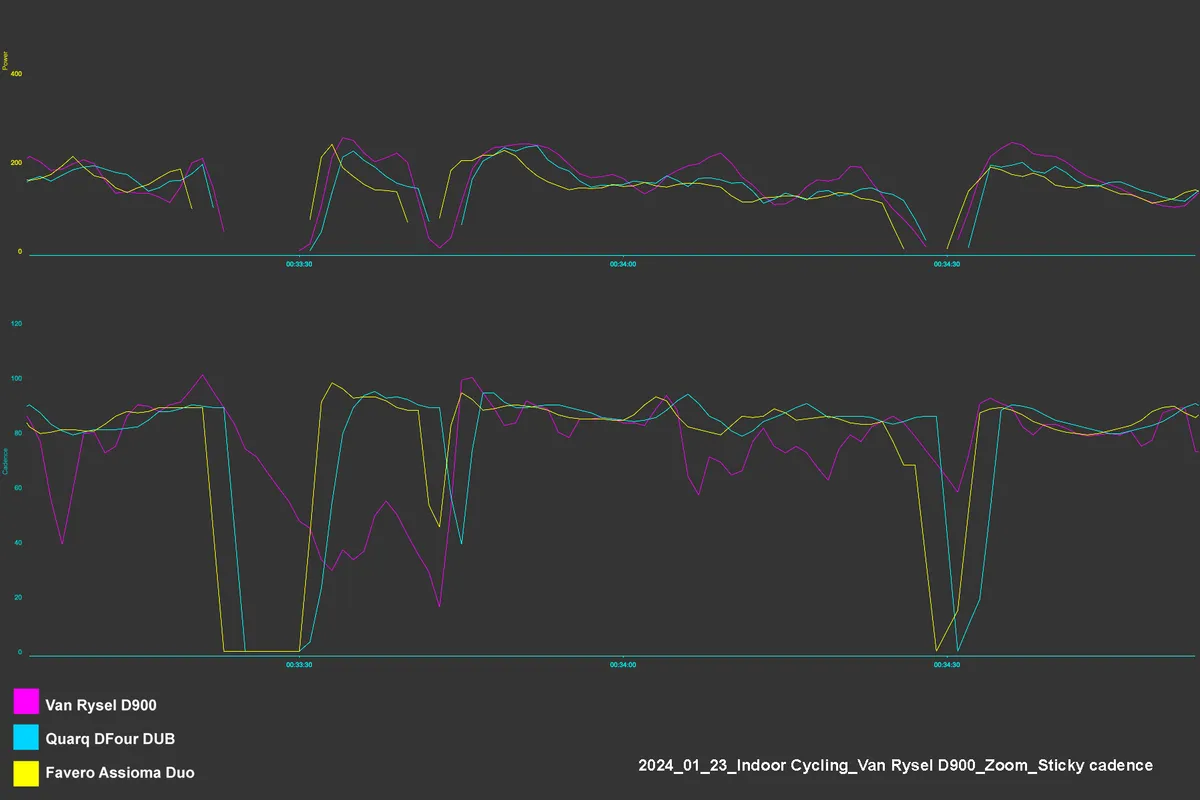
Van Rysel D900 bottom line
Van Rysel’s D900 smart trainer does a lot of things right, but ultimately lacks refinement when it comes to data accuracy, doesn’t include a cassette and lacks a few features I’ve come to expect at this price.
Had it been released two or three years ago, it would have been a shoo-in for a spot on our list of the best smart trainers.
However, the bar for direct-drive smart trainers at this price was raised significantly by the release of the Zwift Hub in late 2022.
The price cuts it prompted from other manufacturers mean the Van Rysel D900 finds itself flanked on all sides by high-performing trainers from more established brands, even if Zwift itself has now exited the trainer market.
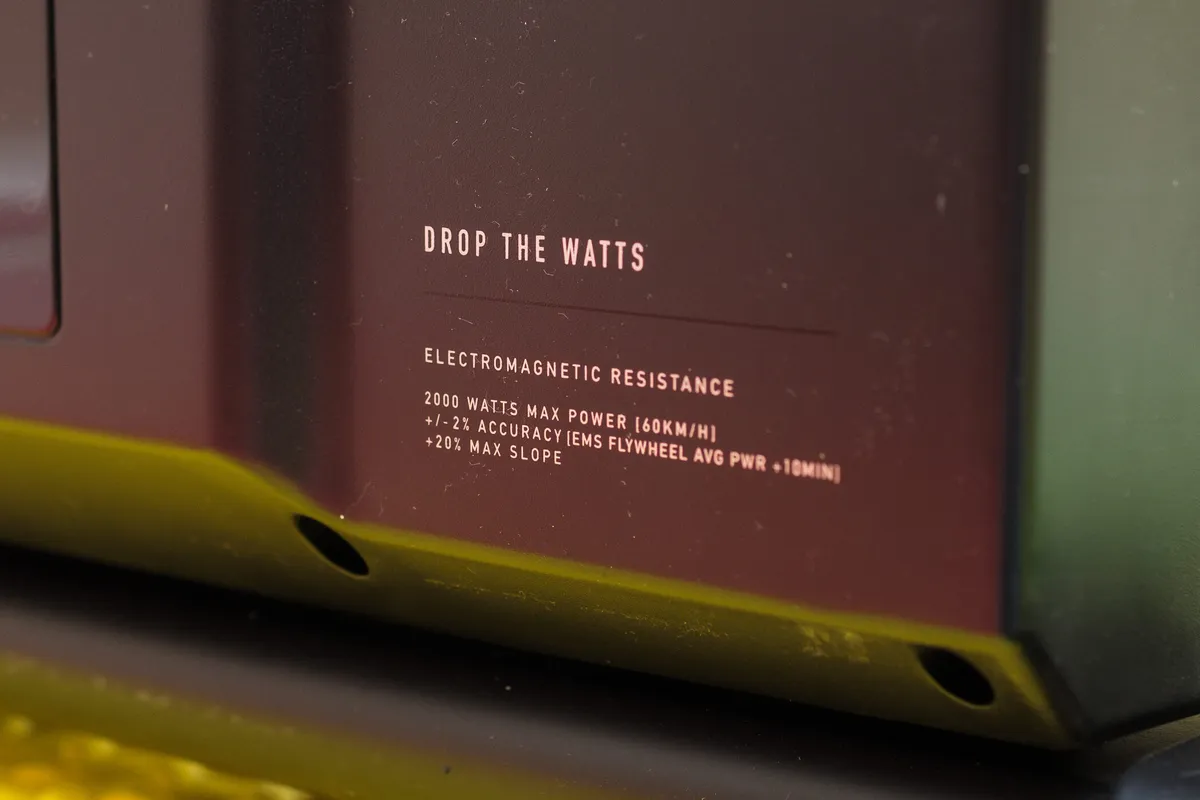
While the Van Rysel D900 offers a higher maximum power output and simulated gradient than most smart trainers at this price, it’s questionable how useful those features are to the average rider.
Measuring sprint power to a lower level with a greater degree of accuracy would be preferable, for example.
With its good ride feel, low noise levels and impressive ERG mode performance, it would be a compelling option if Van Rysel improved on the power data accuracy and added features via future firmware updates.
There’s no guarantee those things will happen, though, so I wouldn’t buy it in expectation.
Product
| Brand | Vanrysel |
| Price | €600.00, £549.99 |
| Weight | 19.00kg |
Features
| Mount | direct_drive |
| Folding legs | no |
| Trainer type | smart_trainer |
| Resistance type | electromagnetic |
| Wheel size | 26in |
| Wheel size | 27_5in_650b |
| Wheel size | 29in_700c |
| Connectivity | antPlus |
| Connectivity | antPlus_fe_c |
| Connectivity | ble |
| Connectivity | bluetooth_smartphone |
| Device compatibility | android |
| Device compatibility | ios |
| Device compatibility | mac |
| Device compatibility | windows |
| Noise | 63.0000 |
| Noise | DECIBEL |
| Max power | 2000.0000 |
| Max power | WATT |
| Flywheel weight | 5.2000 |
| Flywheel weight | KILOGRAM |
| Max grade (degrees) | 20.0000 |
| Hub compatibility | 130/135mm quick release, 12x142mm and 12x148mm thru axle |
